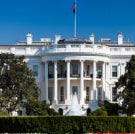This website uses cookies so that we can provide you with the best user experience possible. Cookie information is stored in your browser and performs functions such as recognising you when you return to our website and helping our team to understand which sections of the website you find most interesting and useful.
The US government could be heading for another partial government shutdown later this week unless Congress can agree to a new round of spending bills.
President Joe Biden is meeting with the top congressional leaders at the White House on Tuesday in the hope of kickstarting negotiations after Senate majority leader Chuck Schumer and House speaker Mike Johnson blamed each other’s parties for stalling.
Unless new spending bills can be agreed before Friday 1 March, funding for the departments of agriculture, energy, house and urban development, transportation and veterans affairs will expire.
What’s more, the departments of justice, state and defence will in turn find themselves without cash from Friday 8 March.
While senators returned to Congress on Monday after a brief recess, their House counterparts are not due back at their posts until Wednesday evening, placing even further time pressure on the passage of any funding bills and increasing the likelihood of another stop-gap spending motion or continuing resolution becoming necessary.
Government shutdowns are a recurrent threat looming over Congress whenever the parties of the left and right cannot find common ground on how to bankroll the great offices of state.
Under the Antideficiency Act, which was passed in 1884 and amended in 1950, US government departments and federal agencies cannot spend or commit money without the approval of Congress.
The House and Senate therefore need to assess the budget requests submitted by individual departments and agencies and agree on the 12 appropriation bills that apportion a full year’s worth of funding to those offices before a given deadline, with the spending packages having to pass through both chambers before they can reach the Resolute desk to be signed off by President Biden.
If Congress passes the appropriation bills, the clock is reset for another year and everyone can rest easily.
If it cannot, those departments and agencies affected must cease all non-essential functions until a deal is in place.
If all of the dozen bills are caught up in partisan squabbling, a complete government shutdown takes place. But if some can be agreed to, leaving only a few offices required to close their doors, a partial shutdown is the result.
During federal shutdowns, government employees are told not to report for work and placed on furlough – although, since 2019, they are now paid retroactively when the impasse comes to an end, rather than forced to lose out on wages altogether.
The state of play does not apply to those whose jobs are considered essential for public safety, such as law enforcement officers, soldiers, air traffic controllers, medical personnel, power grid technicians or those responsible for administering social security, Medicare and Medicaid payments.
Transportation Security Administration (TSA) staff fall under this category and would therefore be required to go to work as usual in the event of a shutdown to keep travel open, although they would be expected to do so without immediate pay, an issue that can only be resolved once the shutdown is brought to an end through the successful conclusion of negotiations in Congress.
Such a demoralising and dysfunctional situation is far from ideal, of course, and White House press secretary Karine Jean-Pierre moved to warn the public last autumn that such an eventuality was likely to result in “significant” delays to journeys, advising travellers to plan their trips accordingly.
The US Travel Association estimates that government shutdowns can cost the American economy around $140m per day as greater strain is placed on essential services.



 Africana55 Radio
Africana55 Radio 

